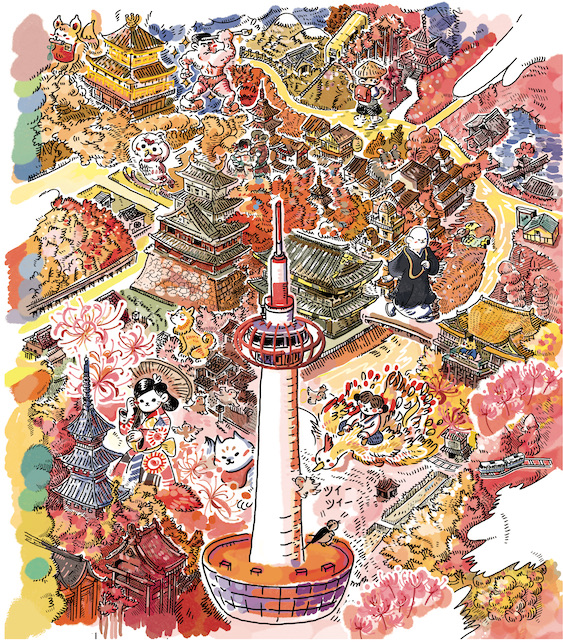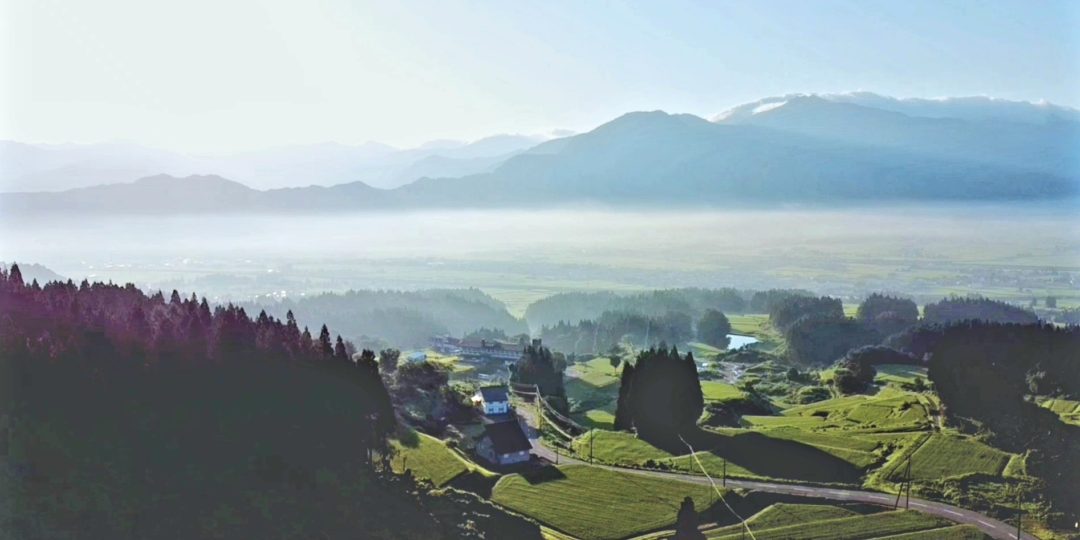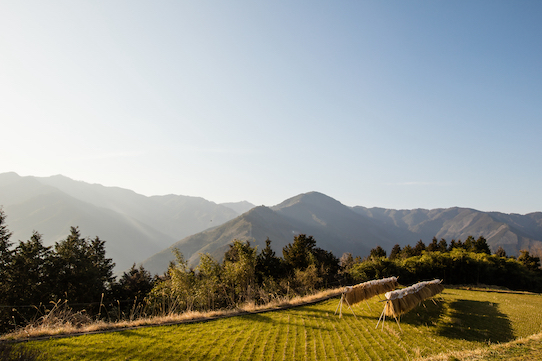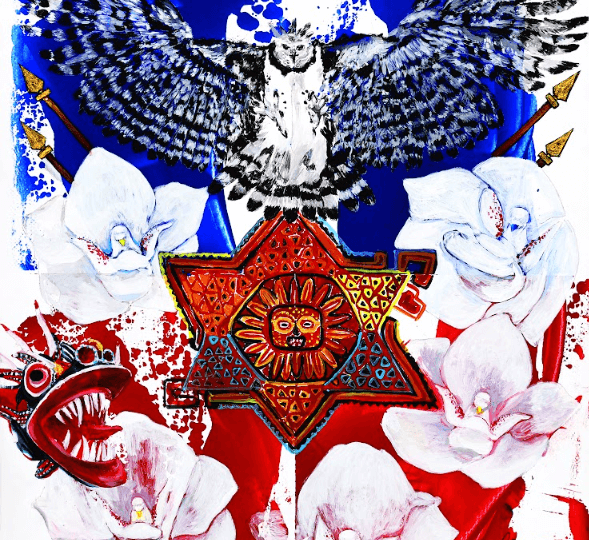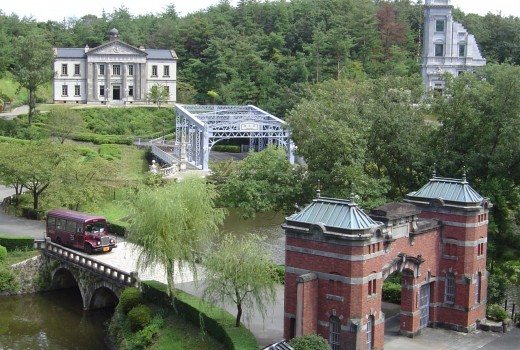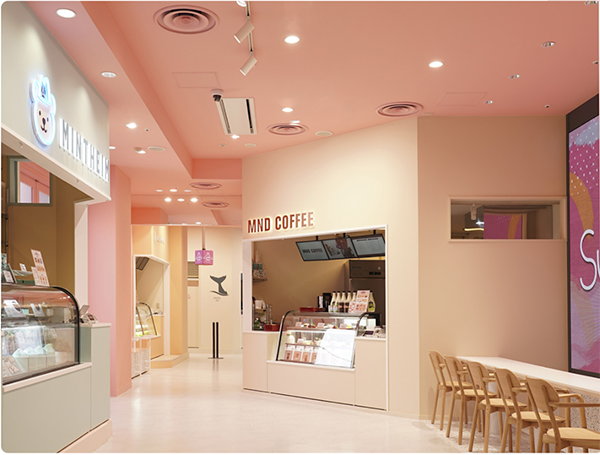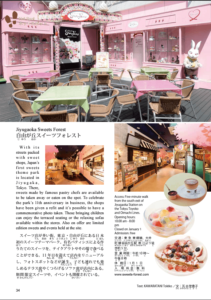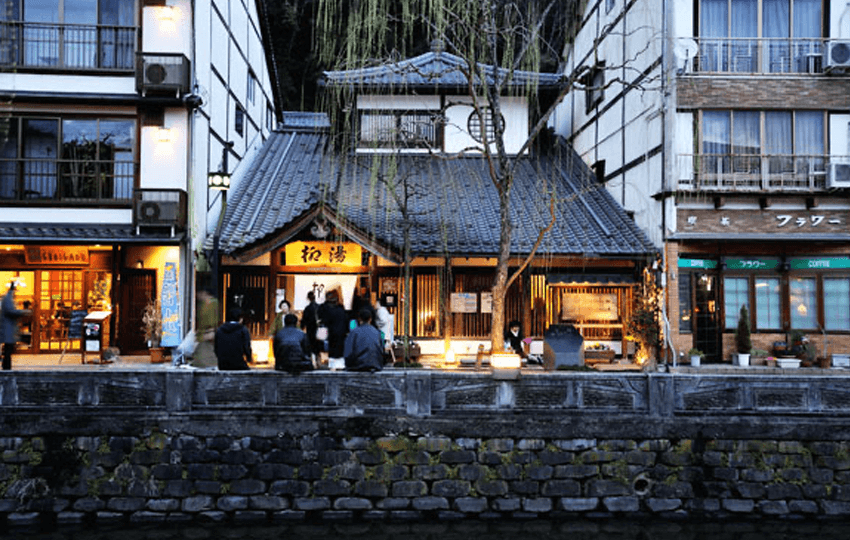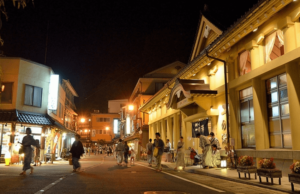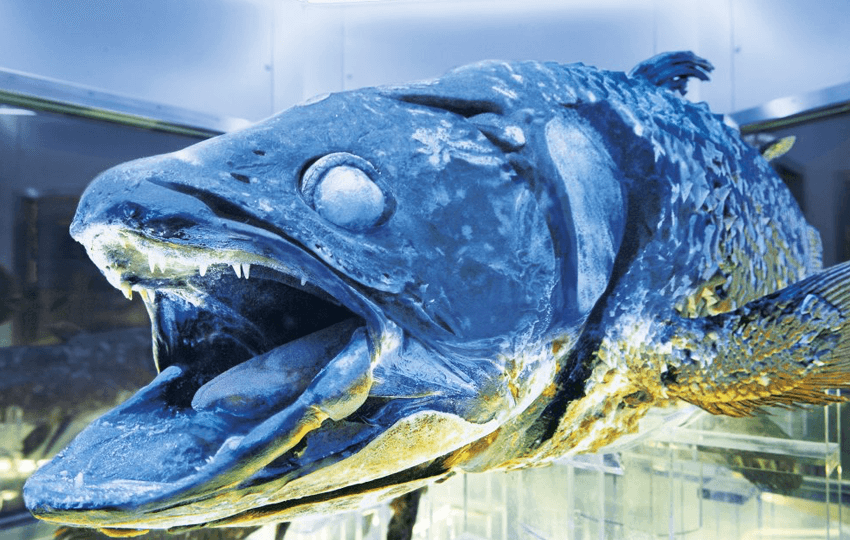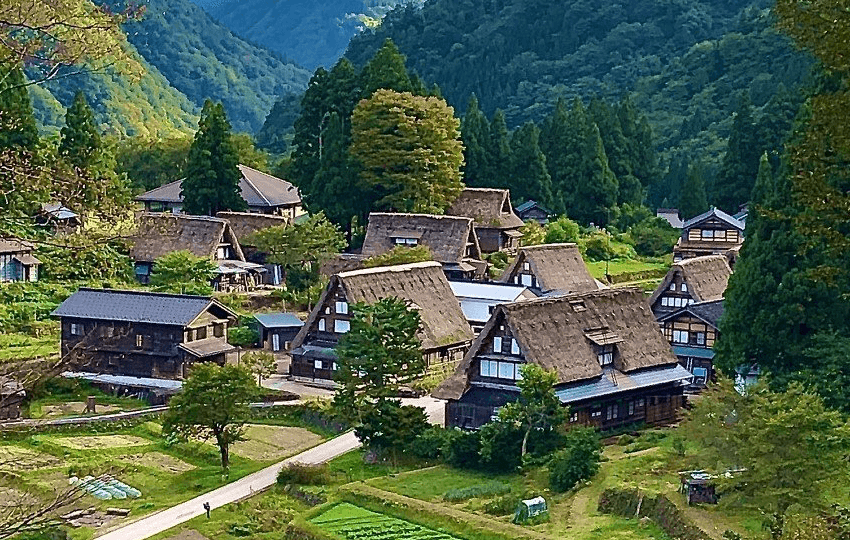-
The Breath of Autumn Illuminates Kyoto — A Tower of Light and the Memory of Red Spider Lilies
- Hiragana Times
- Sep 29, 2025
[Cover Story – September 2025 Issue]
The Breath of Autumn Illuminates Kyoto — A Tower of Light and the Memory of Red Spider Lilies
秋のいぶき、京都に灯る——塔の光と彼岸花の記憶This month’s cover captures a quiet autumnal view of Kyoto, wrapped in warm, seasonal hues.
今月号のカバーは、秋色に染まる京都の街並みを描いた一枚です。
At the center of the scene stands Kyoto Tower, located at the city’s gateway near Kyoto Station. Resembling a tall candle, the tower was inspired by the idea of “a light without fire” in a city filled with wooden architecture.
画面中央にそびえるのは、京都の玄関口・京都駅前に建つ「京都タワー」。まるで一本の大きな蝋燭のようなこの塔は、伝統的な木造建築が多い京都の街に「火を使わない灯り」を灯す、という発想から生まれました。
The tower was completed in 1964—the year of the Tokyo Olympics, a symbolic time when Japan was reemerging on the world stage after World War II. In Kyoto, a city with over a thousand years of history, the tower quietly took its place as a beacon pointing toward the future.
建設されたのは1964年――東京オリンピックの年であり、日本が戦後から立ち上がり、世界に向けて再出発した象徴的な年でもあります。千年の都・京都に立てられたこの塔は、「未来へのともしび」として、人々の希望を静かに照らしてきました。
In the depicted landscape, Kyoto’s iconic temples and shrines—such as Kiyomizu-dera, Kinkaku-ji, Nijō Castle, and Fushimi Inari—are nestled among trees adorned in brilliant autumn leaves, deepening the richness of the scene.
描かれた風景には、紅葉に染まる京都の街並みに、清水寺や金閣寺、二条城、伏見稲荷など、数多くの歴史的建築が点在し、秋の彩りとともに風景に深みを添えています。
Adding a vivid accent of red to the scene are the red spider lilies, or higanbana. Blooming around the autumn equinox, these flowers are also featured in this issue’s Ibuki section, gently evoking memories of ancestors and quiet moments of remembrance.
そこに、鮮やかな赤のアクセントとして咲くのが「彼岸花」。今号の「いぶき」コーナーでも特集しているこの花は、ちょうど秋のお彼岸の頃に咲き、故人を偲び、静かに手を合わせる心を呼び起こします。
In autumnal Kyoto, layers of time overlap, and memory and prayer pass gently through the air.
秋の京都には、時間の層が折り重なり、記憶と祈りがそっと行き交います。
This article is from the September 2025 issue of Hiragana Times.
この記事は、月刊誌『ひらがなタイムズ』2025年9月号より掲載しています。
-
Minamiuonuma City – A Region of Japan Renowned for Its Rice, Cuisine, and Culture
- Hiragana Times
- Nov 18, 2024
Minamiuonuma City – A Region of Japan Renowned for Its Rice, Cuisine, and Culture
南魚沼市——日本屈指の米どころが誇る食と文化
[Place – December Issue 2024]
Niigata Prefecture’s Minamiuonuma City is one of Japan’s foremost rice-producing regions. The premium rice, “Minami-Uonuma-origin Koshihikari brand rice,” is known for its unique stickiness, shine, and fragrant aroma, created by pure snowmelt water and temperature differences between day and night, continually captivating many food enthusiasts.
新潟県南魚沼市は、日本を代表する米どころです。ブランド米「南魚沼産コシヒカリ」は、清らかな雪解け水、昼夜の寒暖差が生み出す独特の粘りと艶、香りの高さで知られ、多くの食通を魅了し続けています。
Minamiuonuma is also one of Japan’s snowiest regions, where the local food culture reflects the snowy environment. For example, vegetables stored in a natural “snow room” (a type of refrigerator that uses snow) gain significantly more sweetness. This preservation method is a tradition of wisdom passed down by ancestors who skillfully harnessed nature’s power.
南魚沼市は全国有数の豪雪地でもあり、雪国ならではの食文化も楽しめます。例えば、雪を利用した天然の冷蔵庫である雪室に貯蔵した野菜は、甘みがグンと増すのです。この保存方法は、自然の力を巧みに利用した先人の知恵の結晶です。The locally produced sake, including the renowned “Hakkaisan,” named after a long-revered sacred mountain, is made from pristine, cold water and high-quality rice, delighting sake enthusiasts nationwide. Additionally, “hegisoba,” a type of soba noodle that uses the seaweed “funori” as a binder, is loved for its unique texture and flavor.
古くから霊山としてあがめられてきた山の名を冠した「八海山」をはじめとする、清らかで冷たい水と良質な米から生まれる日本酒は、全国の酒好きを唸らせます。また、海藻の一種「ふのり」をつなぎに使用した「へぎそば」も、独特の歯ごたえと風味で愛されています。As for cultural heritage, the linen fabric “Echigo jofu” is recognized as a UNESCO Intangible Cultural Heritage, and the silk fabric “Shiozawa tsumugi,” known for its graceful luster, is designated as a traditional craft. These textile industries developed around Shiozawa-juku, a post town along the historic Mikuni Road that once connected Edo and Echigo, and traces of history can still be seen today on “Bokushi-dori Street” in Shiozawa-juku.
文化的遺産としては、麻織物「越後上布」がユネスコ無形文化遺産に、優美な光沢が特徴の絹織物「塩沢紬」が伝統工芸品に指定されています。これらの織物産業は、かつて江戸と越後を結んだ三国街道の宿場町だった塩沢宿[ルビ:しおざわじゅく]を中心に発展し、現在も「塩沢宿 牧之通り」に歴史の面影が残ります。In spring, the “snow bleaching” of Echigo jofu is performed. This traditional technique uses snow to bleach the fabric, and the sight has long been a hallmark of the season.
春には越後上布の「雪ざらし」が行われます。雪を利用して布を漂白する伝統的な技法で、その光景は古くから春の風物詩となっています。Another attraction in Minamiuonuma is the abundance of hot springs nurtured by snowmelt. The various hot springs scattered across the city each have unique mineral qualities that soothe both body and mind.
雪解け水が生み出す豊富な温泉も南魚沼市の魅力の一つです。各所に点在する温泉地では、それぞれの独特の泉質が人々の心身を癒やしています。
The picturesque landscapes shaped by rich nature, culinary culture, and tradition leave a beautiful and lasting impression on visitors to Minamiuonuma City.
豊かな自然、それを活かした食文化と伝統が織りなす風景は、南魚沼市を訪れた人に美しい余韻を残してくれることでしょう。(Access)
・Approximately 1 hour and 30 minutes by Joetsu Shinkansen from Tokyo Station to Echigo-Yuzawa Station, followed by about 15 minutes from Echigo-Yuzawa Station to Shiozawa Station via the JR Joetsu Line or Hoku Hoku Line.
・Approximately 2 hours and 30 minutes by car from Tokyo (Nerima IC) via the Kan-Etsu Expressway.
・About 2 hours by car from Niigata Airport.
(アクセス)
・東京駅から上越新幹線で越後湯沢駅まで約1時間30分、越後湯沢駅からJR上越線またはほくほく線で塩沢駅まで約15分
・東京(練馬IC)から関越自動車道利用で約2時間30分
・新潟空港から車で約2時間
-
Shiiba Village, Miyazaki Prefecture: A Hidden Mountain Sanctuary Where History and Culture Live On
- Hiragana Times
- Oct 19, 2024
Shiiba Village, Miyazaki Prefecture: A Hidden Mountain Sanctuary Where History and Culture Live On
宮崎県椎葉村——歴史と文化の息づく山岳地帯の秘境[Place – November 2024 Issue]
Deep in the mountains of Kyushu lies Shiiba Village in Miyazaki Prefecture. Alongside Shirakawa-go in Gifu Prefecture and Iya in Tokushima Prefecture, it is considered one of Japan’s three great hidden regions. This mystical village, situated in a rugged, densely forested mountainous area, is dotted with small settlements.
九州山地の奥深くに位置する宮崎県椎葉村。ここは、岐阜県の白川郷、徳島県の祖谷[ルビ:いや]と並ぶ日本三大秘境の一つ、険しく緑深い山岳地帯に集落が点在する神秘的な村です。
In the village, a distinctive culture has flourished in the daily lives of its people for centuries. “Shiiba Kagura,” a sacred dance dedicated to the gods, has been passed down for over 600 years and is performed throughout the night. This kagura was designated as an Important Intangible Folk Cultural Property by the Japanese government in 1978 and remains one of the village’s greatest sources of pride.
村では、古くから人々の生活に特色ある文化が息づいています。600年以上受け継がれてきた「椎葉神楽」は神々への奉納の舞で、夜を徹して行われます。この神楽は1978年に国の重要無形民俗文化財に指定され、村の誇りのひとつとなっています。The village is also known for its stunning natural beauty. Highlights include the “Okubo No Hinoki” cypress tree, which is over 800 years old and designated as a National Natural Monument, and the towering “Yamura Sugi,” which stands 54.4 meters tall. The moss-covered trees in the wetlands of Shiratori Mountain are often enveloped in thick mist, and the area is revered as a sacred place by the villagers.
大自然も村の魅力のひとつです。国の天然記念物である樹齢800年の「大久保のヒノキ」や、54.4mの高さを誇る「八村杉」など、そのスケールは人々を圧倒します。苔むした木々が立ち並ぶ白鳥山の湿地帯は時に霧が深く立ちこめ、村人に聖地としてあがめられています。Shiiba Village is also famous as the place where the survivors of the Taira clan, who were defeated in the Battle of Dan-no-ura at the end of the Heian period, took refuge. Their sorrowful yet beautiful story is still passed down today, reminding people that Shiiba was an important chapter in Japan’s history.
椎葉村は、平安時代末期に壇ノ浦の戦いで敗れた平家の落人たちが隠れ住んだ場所としても知られています。彼らの悲しくも美しい物語は今も語り継がれ、椎葉村が歴史の重要な舞台であったことを伝えています。The village preserves the traditional Japanese rural landscape, featuring terraced rice fields and stone walls. Particularly notable is the traditional slash-and-burn farming, which has been recognized for its contributions to environmental preservation, earning it a designation as a Globally Important Agricultural Heritage Site in 2015.
集落には棚田や石垣など、昔ながらの日本の農村の景観が残されています。特に、伝統的な焼畑農業は環境保全の観点からも評価され、2015年に世界農業遺産に認定されました。Shiiba Village is a mystical place where culture, history, and nature intertwine. This hidden sanctuary, untouched by the passage of time, leaves a profound and lasting impression on all who visit.
文化、歴史、そして自然が織りなす神秘の舞台、椎葉村。この秘境は、時代の波に揺るがぬ魅力を放ち、訪れる者の胸に深く刻まれることでしょう。Access
Approximately 1 hour and 45 minutes from Haneda Airport to Miyazaki Airport, followed by a 1 hour and 30 minute train ride on the JR Nippo Main Line from Miyazaki Airport Station to Hyuga City Station, and then a 2 hour and 30 minute bus ride from Hyuga City Station.
・About a 3-hour drive from Miyazaki City.
・About a 2-hour and 15-minute drive from Kumamoto City.アクセス
羽田空港から宮崎空港まで約1時間45分、JR日豊本線宮崎空港駅から日向市駅まで1時間30分、日向市駅から路線バスで約2時間30分
・宮崎市より車で約3時間
・熊本市より車で約2時間15分 -
The Canvas of Cultural Fusion: The Allure of Panama – 文化融合のキャンバス:パナマの魅力
[Hiragana Times EXPO – March 2024 issue]
In this Pavilion corner, vibrant artworks featuring the colors of Panama’s national flag, blue and red, are showcased.
今回のパビリオンは、パナマ共和国の国旗色[こっきしょく]、青と赤を基調に描かれた鮮やかな作品となりました。
The bird with spread wings represents Panama’s national bird, the Harpy Eagle, symbolizing independence and freedom. The ten shining stars above its head symbolize the unity of Panama’s ten provinces. In the center, there is a symbol of the sun and stars, inspired by the woven fabric“Mola”of the indigenous Kuna tribe, who worship nature.
翼を広げた鳥は、独立と自由を表すパナマの国鳥ハーピーイーグル(オウギワシ)。頭上に輝く10の星は、パナマ10州の結束を象徴しています。中央には、自然を崇拝する先住民クナ族の織物[おりもの]「モラ」からインスピレーションを受けて描かれた太陽と星のシンボル。
Surrounding it, Panama’s national flower, the“Espíritu Santo”or“Holy Spirit Orchid,” is characterized by its pure white petals with a dove seemingly perched at the center. In the background, numerous spears stand tall, symbolizing guarding peace and tranquility. Panama’s strength and purity coexist.
それを取り囲むパナマの国花エスピリトゥ・サント、別名「聖霊蘭[せいれいらん]」は、純白の花びらの中央に鳩が鎮座しているように見えるのが特徴です。背後には何本もの槍が平和と静寂を守るように力強く佇み、強靭と純粋が共存するパナマを示しています。
The annual“Carnival de Panama”showcases the rich diversity of Panamanian culture. During the early 20th-century construction of the Panama Canal, many Chinese laborers migrated to Panama. The timing of the carnival, which coincides with China’s Spring Festival (Lunar New Year), has led to the incorporation of Asian culture into the festivities. The Chinese lion dance depicted on the bottom left side represents this influence.
毎年盛大に開催される「カーニバル・デ・パナマ」には、パナマ文化の多様性が強く感じられます。20世紀初頭のパナマ運河建設時には、多くの中国人労働者がパナマに移住しました。そして、カーニバルの行われる時期が中国の春節[しゅんせつ](旧正月)に近いこともあり、カーニバルにはアジア文化も取り入れられています。下段左側に描かれている中国獅子舞がそれを表しています。
The fusion of tradition and culture, along with the generous spirit of the people, has created a remarkable masterpiece captured on a single canvas.
伝統と文化の融合、そして国民のおおらかな精神が、1枚のキャンバスに捉えられた見事な作品となりました。
-
This outdoor museum has a collection of rare architecture built in the Meiji era (19th to 20th centuries). This year it celebrates its 50th anniversary. Here you can enjoy a light meal at the former Imperial Hotel built by the distinguished American architect Frank Lloyd WRIGHT. Steam locomotives, retro Kyoto trams, and buses are operated every day, and can be used to move around the vast grounds. Many seasonal events are held, including sessions where visitors can wear kimono or hakama and have a commemorative photo taken. It is often used as a location for movies.- Access: 20-minute bus ride from Inuyama Station on the Meitetsu Inuyama Line. Near the Meiji-mura bus stop.
- Business hours: from 9:30 am to 5:00 pm (hours differ depending on the season)
- Closed days: August 4, 18, 25, December 31, every Monday from December to February. Closed on some days in January for maintenance.
- Admittance: 1,700 yen for adults (aged 18 and over). 2,700 yen for a ticket with a one-day pass for rides.
Meiji-mura Museum
明治時代(19~20世紀)を中心とした貴重な建造物を集めた野外博物館。今年オープンから50年を迎えた。著名なアメリカ人建築家、フランク・ロイド・ライトが建てた旧帝国ホテルでは軽食が楽しめる。蒸気機関車やレトロな京都市電、バスが毎日運転を行い、広大な敷地内の移動に利用できる。着物や袴姿での記念撮影体験や、季節ごとのイベントも数多く開催。映像作品のロケに使われることも多い。- 交通:名鉄犬山線犬山駅から路線バス明治村行き20分、下車すぐ。
- 営業時間:午前9時30分~午後5時(季節によって時間帯の変更あり)
- 休村日:8月4日、18日、25日、12月31日、12~2月の毎週月曜日。1月に数日間メンテナンス休日あり。
- 入村料:大人(18歳以上)1,700円、乗り物一日券付きは2,700円
-
[:ja][2015年7月号掲載記事]
スイーツ店が多い街、東京・自由が丘にある日本初のスイーツテーマパーク。有名パティシエによる作りたてのスイーツを、テイクアウトやその場で食べることができる。11年目を迎えて店内をリニューアルし、フォトスポットなどが誕生。子ども連れでも楽しめるテラス席やくつろげるソファ席が店内にある。期間限定スイーツや、イベントも開催されている。
- 交通:東急東横線、大井町線自由が丘駅南口より徒歩約5分。
- 営業時間:午前10時~午後8時
- 休館日:1月1日
- 入場料金:無料
自由が丘スイーツフォレスト[:en][From July Issue 2015]
With its streets packed with sweet shops, Japan’s first sweets theme park is located in Jiyugaka, Tokyo. There, sweets made by famous pastry chefs are available to be taken away or eaten on the spot. To celebrate the park’s 11th anniversary in business, the shops have been given a refit and it’s possible to have a commemorative photo taken. Those bringing children can enjoy the terraced seating or the relaxing sofas available within the stores. Also on offer are limited edition sweets and events held at the site.
- Access: Five-minute walk from the south exit of Jiyugaoka Station on the Tokyu Toyoko and Oimachi Lines.
- Opening hours: 10:00 am – 8:00 pm
- Closed on January 1
- Admission: free

-
[:ja][2015年6月号掲載記事]
温泉宿といえば通常1泊2食付きです。宿の食事は旅の楽しみでもありますが、食事が付くことで料金は高くなります。食事が付かない低価格の素泊まりの温泉宿はこれまでもありましたが、ほとんどが長期滞在して体を癒す湯治客向けの簡素なものでした。近年、その2つの宿の長所を取り込んだ新しい形の温泉宿が増えています。
大分県別府市の鉄輪温泉で2012年に開業した素泊まり専用宿「癒しの宿 彩葉」はすべての客室が温泉付きの離れというぜいたくな造りです。アメニティーも充実しており館内には無料のドリンクサーバーもあります。料金は2名1室利用の場合、平日1名8,640円(税込)から。温泉宿としては安めに設定されています。
彩葉を運営する株式会社ニューグロリアリゾートでは、大分県の別府温泉と湯布院温泉で11の温泉旅館を経営しています。そのうちの3軒が素泊まり専用です。「1泊2食にこだわっていては多種多様化するお客様のニーズにこたえることができないと考えました」と宿のチーフ、日野正剛さんは説明します。
近隣に飲食店が多かったことも素泊まり宿にした大きな要因です。また、食事のサービスがないことでお客が時間にしばられずに行動できるようになるのではないかとも考えました。開業後、利用客は予想通り20~30代のカップルや幼児連れの若い夫婦が多く、「部屋でのんびりするよりも街を散策される方のほうが多いようです」と日野さんは話します。昨年7月、兵庫県城崎温泉の旅館「錦水」は別館をリニューアルし、素泊まり専用の宿「街のねどこkinsui」をオープンしました。錦水は1泊2食付きで平均18,000円ですが、街のねどこは1泊5,000円(税込)で泊まることができます。
錦水でも素泊まりプランは扱っていましたが、利用する設備やサービスの面から価格はどうしても8,000~9,000円になっていました。城崎には学生カップルの観光客が多く、オーナーの大将伸介さんは、彼らが利用しやすい価格にするためにはもっと思い切る必要があると考えました。
宿泊費を抑えるためにタオル類の貸し出しは有料、布団も自分で敷きます。本館の内湯を利用する場合は有料です。そのかわり湯めぐりパスの「ゆめぱ」を使って城崎温泉の7つの外湯に無料で入ることができます。「宿の外のお風呂や飲食店を利用することで、城崎の街全体を楽しんでもらえる機会をつくれればと思いました」。街のねどこという名前にも街歩きを満喫し寝るときだけ帰るという、その思いを込めたと大将さんは話します。
大将さんは、低価格でシンプルに旅館という文化を楽しみたい若いお客と外国人客が増えていると実感しています。宿泊費の安い街のねどこを旅の拠点にし、京都に日帰り旅行をする観光客もいます。新しいスタイルの温泉宿が生まれたことによって、利用方法も広がりつつあります。文:市村雅代[:en][From June Issue 2015]

Inns at hot springs usually offer half-board accommodation – i.e., one night’s lodging with breakfast and dinner. Although meals are a part of the pleasure of traveling, they increase the expense. Up until now, low-cost lodging that doesn’t include meals has been on offer, but most of these are simple accommodations aimed at people staying long-term at a spa for health reasons. Recently more and more new-style hot spring hotels that offer the advantages of both types of lodging are appearing.
Opened in Kannawa Onsen (Hot Springs), Beppu City, Oita Prefecture in 2012, “Iyashinoyado Iroha,” an inn that offers lodging without meals, is lavishly constructed; all of its guest rooms are cottages set apart from the main building with their own hot springs. It’s well fitted out with amenities, including a free-of-charge drinks dispenser. When a room is occupied by two people, the fee for one person a night on a weekday starts from 8,640 yen, including sales tax. For a hot-spring inn, this price is rather low.
New Gloria Resort, Co., Ltd., which operates Iroha, has 11 hot-spring inns in Beppu Hot Springs and Yufuin Hot Springs – both in Oita Prefecture. Among these, three exclusively provide lodging without meals. “We thought we could not meet the diversifying needs of our guests if we stuck to offering half board only,” explains HINO Masatake, manager of the inns.
One of the main factors affecting the company’s decision to offer accommodation without meals was the large number of restaurants in the neighborhood. The reasoning is that without a meal service, guests would be free to act as they pleased without being tied to a schedule. After opening, many of the guests have been couples in their 20s and 30s, as well as young married couples with small children. “It seems that most guests prefer to walk around the town rather than to relax in their rooms,” says Hino.Hot Spring Inn Kinsui in Kinosaki Hot Springs, Hyogo Prefecture, opened “Machi no nedoko kinsui” – a refurbished annex dedicated to providing lodging without meals – in July 2014. While Kinsui offers a one-night package including two meals for one person for around 18,000 yen, it costs 5,000 yen per night, including tax, to stay at Machi no nedoko.
Although Kinsui already had plans to offer lodging without meals, bearing in mind the facilities and services provided, the charge had to be at least 8,000 or 9,000 yen. Seeing as there were many student couples among the sightseeing guests in Kinosaki, owner TAISHO Shinsuke thought that a bold step was required in order to make accommodation available to these people.
To keep the accommodation charges low, towel rental is available for a fee, and guests themselves have to lay out their own futon. They are charged if they use the indoor bath in the main building. But, this includes a “Yumepa” pass that allows them to use seven other outdoor baths in Kinosaki Hot Springs without charge. “I thought that, by allowing our guests to use baths and restaurants outside our inn, we would give them the opportunity to enjoy the whole town of Kinosaki,” Taisho says. The name “Machi no nedoko” conveys Taisho’s idea that the inn is a place to sleep at after enjoying a walk around town.
Taisho feels that the number of young guests and international guests who want to enjoy the culture of a Japanese- style inn at a low-price without any hassle is increasing. Some sightseeing guests use the low-priced Machi no nedoko as a base to travel from when they take day trips to Kyoto. With the advent of new-style hot spring inns, the ways people use them are expanding, too.Text: ICHIMURA Masayo[:]
-
[:en][From June Issue 2015]
This aquarium is the only one in the world that has coelacanth – so called living fossils that are protected by the Washington Convention – on display. There it’s possible to see five mounted coelacanth, two of which are cryogenically preserved. Also exhibited are deep-sea creatures found in Suruga Bay, Japan’s deepest bay. Additionally, you can enjoy observing the movements of species including giant isopods and chambered nautilus, and observe unusually shaped creatures collected from around the world in their natural habitats.
Access: A 15 minute bus ride to Numazu-ko from the south exit of Numazu Station on the JR Tokaido Line.
Opening hours: From 10 am to 6 pm (It’s possible to enter up until 30 minutes before closing.)
Dates: Open throughout the year except for temporary closures.
Admittance: 1,600 yen for senior high school students or adults, 800 yen for children or junior high school students, 400 yen for infants aged four or over, 100 yen discount for senior citizens aged 65 or over (with identification).
Numazu Deepsea Aquarium & Coelacanth Museum[:] -
[From May Issue 2015]
At Jigokudani Yaen-koen (Monkey Park) in Nagano Prefecture there are macaque monkeys known for their habit of bathing in hot springs. Visited by tourists the world over, these macaques are called “snow monkeys” in English.
The Park has some rules for visitors. Feeding the monkeys is forbidden because they can attack tourists for food. Touching the monkeys and prolonged eye contact isn’t allowed either because they will become wary. You can bring neither dogs nor cats with you. The monkeys are unafraid of humans and aren’t bothered by the tourists’ excited cries nor flash photography because visitors have always followed these rules.
The monkeys of Jigokudani used to flee as soon as they saw humans. In those days, some locals tried to exterminate them because they were running amok in fields after their habitat was lost to mountain and forest development schemes. Couldn’t there be a way to protect the farms and people’s livelihoods, while also protecting the monkeys and their living environment? Those who thought this way tried to keep the monkeys from going to the farms by creating a feeding site in Jigokudani far from any human habitation.
At that time Jigokudani was a small resort town with only one old inn and a vigorous hot spring. If its monkeys, its un-spoilt natural habitat and hot spring were turned into tourist attractions, the municipality would reap the economic benefits. This idea, which predated the emergence of ecotourism, kick started the effort to get the monkeys used to humans. With help from the inn, the locals successfully fed the monkeys and five years later in 1964, the park opened.
The monkey bath was created after baby monkeys started playing in the open-air bath of the spa inn – that had been lending its support to the park. Today, the park has open-air baths for the monkeys where many of them bathe on cold days. People visit in droves to take pictures. In this way, photos taken there have won prizes both in and outside Japan and created quite a buzz. In recent years this has led to an increase in the number of winter visitors and foreign tourists.
Though some might think the park is a winter attraction, it’s actually open throughout the year. It’s not only for tourists, but is also an institution for education and research. In the spring baby monkeys are born one after the other. Their hair is still black and you can witness the charming spectacle of suckling babies cradled in their mother’s arms. In the summer, you can see them enthusiastically playing around, independent from their mothers.
As records of the name and mother of each and every monkey covering the past 50 years have been kept by the park, university researchers visit for fieldwork from within and without Japan. The park is also used by elementary and junior high school students for outdoor classes. To get to the park, it’s a two-kilometer half-hour walk on a mountain trail from the dedicated Monkey Park parking lot. Hiking clothes will therefore be necessary and you’ll need to prepare for cold temperatures in wintertime.
Jigokudani Yaen-koen
Text: SAZAKI Ryo[2015年5月号掲載記事]長野県にある地獄谷野猿公苑には、温泉に入ることで知られるニホンザルがいます。英語では「スノーモンキー」と呼ばれ、世界中から観光客が訪れます。
野猿公苑にはルールがあります。観光客がえさをやると、サルがえさ欲しさに人を襲うようになるので禁止です。サルをさわったり目を見つめたりするのも警戒心を起こさせるのでだめです。イヌやネコを連れていってはいけません。観光客がルールを守ってきたため、サルは人間を恐れず、観光客の歓声もフラッシュを使っての撮影も気にしません。
かつて地獄谷のサルは、人間を見るとすぐ逃げていました。その頃は山林の開発が進んで住む場所を追われたサルが畑を荒らしたため、殺そうとする動きもあったからです。サルやサルが生きられる環境を保護しつつも、人間の畑や生活を守る方法はないだろうか。そう考えた人たちは人里から離れた地獄谷をえさ場とすることで、サルが畑に行かないようにしました。
地獄谷はとても熱い温泉が激しく噴き出す、古い温泉旅館が一軒だけある小さな保養地でした。サルや手つかずの自然、温泉を観光資源とすれば、地元にも経済効果があります。このようなエコツーリズムの先取りともいえる発想から、サルの群れを人に慣れさせる作業が始まりました。温泉旅館の協力もあって5年後にえづけに成功し、1964年に公苑がオープンしました。
サルの温泉は、公苑を支援してきた温泉旅館の露天風呂に、子ザルが入って遊ぶようになったことから生まれました。今では公苑内にサル専用の露天風呂があり、寒い日には多くのサルが浸かっています。たくさんの人が訪れ、撮影します。そのようにして撮られた写真が国内外で賞をとって話題になりました。そのため、近年、冬期の入苑者や外国人観光客が増えています。
冬の観光地と思う人もいるかもしれませんが、年間を通じて運営されています。観光だけでなく教育、研究のための施設でもあります。春には、子ザルが続々と誕生します。子ザルはまだ毛も黒く、母親に抱っこされておっぱいを飲む愛らしい姿を見せてくれます。夏になると母親から離れて元気に遊びまわる姿が見られます。
公苑では50年にわたってサル一匹一匹の名前や母子関係が記録されているため、国内外の大学から研究者が訪れ、フィールドワークが行われています。小中学生の野外学習にも役立てられています。公苑へ行くには、上林温泉の野猿公苑専用駐車場から山道を約2キロ、約30分歩きます。ハイキングの服装、特に冬は防寒対策が必要です。
地獄谷野猿公苑
文:砂崎良 -
[From May Issue 2015]
In Nanto City, Toyama Prefecture there are two villages with unique so called “gasshou-zukuri” style steeply sloping thatched roofs. This year marks the 20th anniversary since they were registered as a World Heritage Site. While most of the houses were built around 100 to 200 years ago, some of them have a history of around 400 years. Residents still live in them and at houses where accommodation and meals are provided, guests are served edible wild plants and iwana mountain trout by the hearth. The site is also a centre of production for washi Japanese paper and visitors can make round fans and postcards by taking part in the Japanese paper-making experience. From around mid-May every year, Ainokura Village is illuminated to create a magical Japanese countryside scene that will delight visitors.
Access: At JR Shin-Takaoka Station, get on the “World Heritage”bus, get off at “Ainokuraguchi”and walk about five minutes to Ainokura Village, or get off at “Suganuma” and walk about three minutes to Suganuma Village.
Gokayama Tourist Information Center
Opening hours: 9:00 a.m. – 5:00 p.m.
To park in the villages you must pay a fee that will be used for the conservation of these properties: 500 yen for standard or light vehicles, 100 yen for two-wheeled vehicles.
http://www.gokayama-info.jp/
Text: KAWARATANI Tokiko[2015年5月号掲載記事]富山県南砺市にある2つの集落で、合掌造りと呼ばれるかやぶき屋根が特徴。今年世界文化遺産登録20周年を迎える。100~200年前のものが多いが、約400年前に建てられたものもある。住民が今も生活しており、民宿ではいろりのそばで山菜やイワナが食べられる。和紙の産地としても知られ、和紙すき体験ではうちわやはがきを作ることができる。毎年5月中頃には相倉集落はライトアップされ、幻想的な日本の原風景が楽しめる。
交通:JR新高岡駅から世界遺産バスで「相倉口」下車、相倉集落まで徒歩約5分。または「菅沼」下車、菅沼集落まで徒歩約3分。
500 yen for standard or light vehicles, 100 yen for two-wheeled vehicles.
五箇山総合案内所
営業時間:午前9時~午後5時
相倉、菅沼集落の駐車場を利用するには、集落保存協力金として駐車代が必要。普通車、軽自動車500円、二輪車100円。
http://www.gokayama-info.jp/
文:瓦谷登貴子
Information From Hiragana Times
-
 February 2026 Issue
January 21, 2026
February 2026 Issue
January 21, 2026 -
 January 2026 Issue – Available as a Back Issue
January 15, 2026
January 2026 Issue – Available as a Back Issue
January 15, 2026 -
 December 2025 Issue —Available as a Back Issue
November 20, 2025
December 2025 Issue —Available as a Back Issue
November 20, 2025

